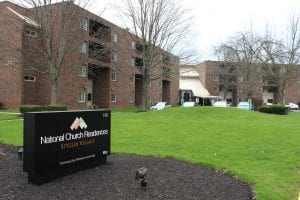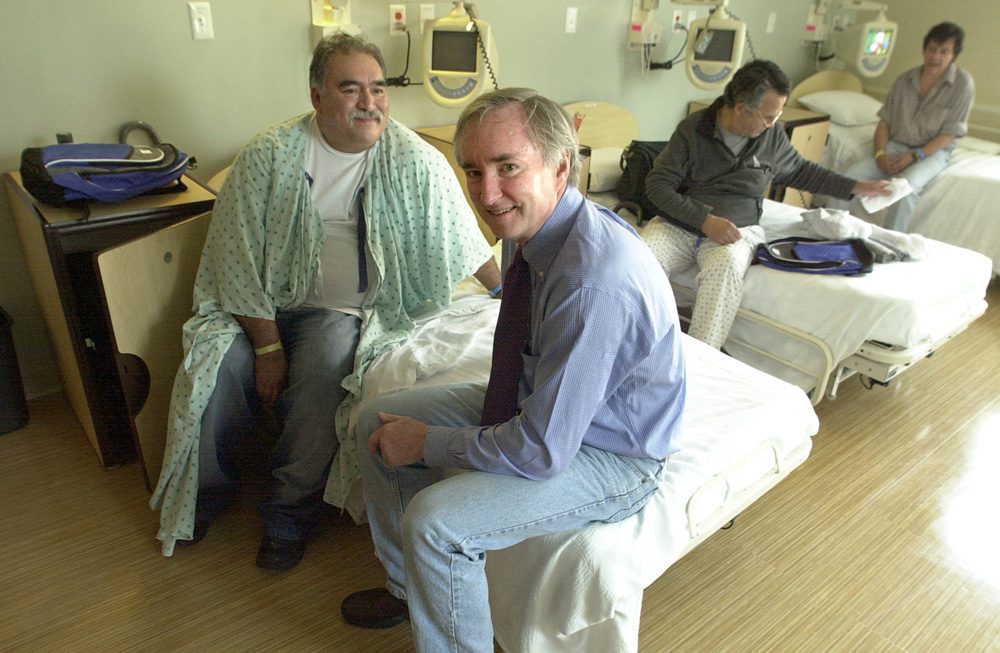
Photo courtesy of the Skid Row Housing Trust

Photo courtesy of the Skid Row Housing Trust
As a community development practitioner for 20 years, I’ve been encouraged by the momentum building within the community development space to partner with the health field to achieve the common goal of helping people live better, longer, and more productive lives.
There is growing awareness of the social determinants of health, the conditions in which we live and work that influence our overall health. In addition, the passage of the Affordable Care Act (ACA) put some teeth behind the idea of paying for health outcomes instead of procedures. These evolving principles, along with the never-ending search for new revenue streams to support housing and residential services, have propelled the growing collaboration between the community development and health sectors. This momentum has been particularly leveraged in the affordable housing sector, where stakeholders have actively sought to partner with the health sector to find innovative ways to produce more housing and to deliver more resident services with the goal of improving health outcomes.
There is a significant body of research documenting the health care cost savings associated with investing in housing, particularly housing with supportive services, and housing advocates often emphasize this as a way to encourage the health care system to direct new sources of capital to affordable housing resident services. However, it’s not a good idea to focus on cost savings alone to justify and encourage this work. First, it fails to recognize the full potential value of this partnership. Second, given significant unmet demand, total budget savings might be difficult to realize even though housing investments do improve health outcomes.
While recognizing the potential for significant cost savings, we should primarily focus on better outcomes for people. I believe we can use what the health field terms the “Triple Aim” of health care—lower costs, improved outcomes, and improved access to care—as a guide for collaboration and innovation between the heath and housing sectors. As noted by Josh Bamberger, a primary care physician who has worked with San Francisco’s homeless population for more than two decades, more—traditional health care interventions like new cancer drugs do not have to show cost savings to be considered worthwhile. So why should housing be subjected to this standard?
The Problem With Competition
In health care, competition among insurers or providers can be an important cost-saving strategy for primary care or standardized procedures. However, health insurers or providers are often unwilling to pay for longer-term interventions, like housing, because people could change plans or go to a different provider and insurers cannot be assured that they will be the beneficiaries of the cost savings. The health benefit of a community-level intervention is dispersed among many individuals, so any one insurer reaps only a small percentage of that benefit. Therefore competition among many providers reduces the financial incentive to invest in social determinants of health.
It’s easier to make the case for housing investment based on health care cost savings when that savings accrues more directly to one provider or insurer. For example, when the largest skilled nursing facility (SNF) in San Mateo County was set to close, there were few facilities nearby to absorb the patients who were going to be displaced. However, initial assessments of SNF residents across the county revealed that up to 30 percent of the county’s 1,300 SNF patients could live independently with the right services and support in place. A SNF, or a nursing home, provides round the clock nursing care, medication management, and 24-hour supervision for people who are unable to complete the routines of daily living. SNFs are relatively expensive facilities. The county launched the Community Care Settings Pilot (CCSP) with the goal of keeping patients in their respective counties, or even their current cities, and reducing their use of long-term care. The patients in the pilot program could move back to their homes or senior communities that had appropriate modifications, provided they had support to do so.
More-traditional health care interventions like new cancer drugs do not have to show cost savings to be considered worthwhile. So why should housing be subjected to this standard?
To enable this, the county committed to paying for intensive transitional case management and care coordination as well as housing services and support.
We talked with several patients of the health system who participated in the CCSP during our research for a paper we recently published with Mercy Housing titled “Innovative Models in Health and Housing.” To protect their privacy, we have created this composite case study based on their experiences. Imagine a woman who is 89, a retired house cleaner who has been living in an illegal in-law apartment for 20 years. She has been a frequent visitor to the local emergency department and has had four short inpatient stays due to poorly controlled congestive heart failure and diabetes. She was in stable housing until she fell and broke her hip.
CCSP facilitated talks with her landlord and determined that he would not make needed accommodations to her apartment to allow her to stay there. Given that, before this program she would likely have ended up in an SNF long term. CCSP assisted her in applying for housing at a new affordable housing facility for seniors. She enrolled in a local adult day health program where the on-site nurse administered her long-acting insulin once a day. These provisions kept her from returning to the hospital, or perhaps being placed in an SNF.
In the first six months since this project launched, 41 percent of the 166 clients who were engaged with CCSP moved into a residential care facility, also known as assisted living, which is less costly than an SNF. Additionally, 5 percent of the clients in the pilot moved into independent market-rate housing, 14 percent moved into independent affordable housing units or similar accommodations, and 13 percent stayed in their existing residential settings following modification. The remainder withdrew from CCSP.
For the six months after this program the county’s health care costs are almost 50 percent lower than spending for the six months prior to transition, even after including the costs of the program. The county has saved in excess of $2 million on the 85 clients who have been in the community for at least six months post-transition. Since there is only one Medicaid Managed Care Organization in San Mateo County—the County Organized Health System—individuals do not change plans during or after their participation in the program, and the savings can be realized by the same entity that is funding the program. In places with greater competition, fragmentation in the managed care market can undermine opportunities to capitalize on investment in long-term programs.
Overwhelming Demand
In the U.S., only one in four individuals who qualify for rental assistance receives it. America’s population is getting older and sicker. There is critical unmet demand for both housing and health care. Housing a high-cost patient in a lower-cost way does not always translate into system-wide cost savings, as newly generated savings or capacity is quickly absorbed by the pent-up demand of individuals in need of services for whom there had previously been no capacity to serve.

Stygler Village. Photo courtesy of National Church Residences
A pilot program proposed at Stygler Village in Ohio exemplifies the challenge presented by the demand for services. In 2013 Ohio-based National Church Residences attempted to develop an assisted living facility targeting seniors who could be discharged from more expensive SNFs. As the owner of Stygler Village, a 150-unit building, National Church Residences sought both to preserve 75 units as affordable housing serving seniors, and to reconfigure 75 units to create assisted living units for individuals who would otherwise be housed in SNFs. Reconfiguring the units for assisted living required approval from the state legislature, because the state was seeking Medicaid waivers to fund the project.
Ultimately, the director of the State Department of Medicaid decided not to make the legislative request for the waiver to move forward with the program. Participants believe that one reason might have been that the director of the Department of Medicaid was not convinced that the projected savings of more than $2 million annually would actually be realized, and he was concerned about the implications that not saving money could have on the state’s other health care savings proposals.
The director was concerned about the “woodwork effect,” believing that the transfer of 75 patients would not result in closures or a reduction in the number of SNF beds, but would instead result in those SNFs or beds being occupied by new, eligible Medicaid recipients.
Without access to the Medicaid savings, National Church Residences decided to drop the assisted living units from the redevelopment plan.
Our challenge is to find ways to recognize the value of serving that next patient or family on the wait list, thereby increasing the total population served, at no incremental cost. Being more efficient with every health care dollar and delivering better health outcomes for more individuals should be considered a success, even if we are spending the same amount of money.
Focusing on the Triple Aim
It is critical that both housing and health care advocates keep the “Triple Aim” in mind when positing the benefits of this work. To achieve a new frame that focuses on the “Triple Aim,” the transaction-oriented world of housing development will need to continue to broaden its language beyond the world of rent levels and fiscal cost-benefits. At the same time, the health world will need to continue to push public and private insurers to embrace upstream, nonmedical approaches to improving health. We need to keep reminding ourselves that serving more people with the same amount of money is not a failure.




Comments